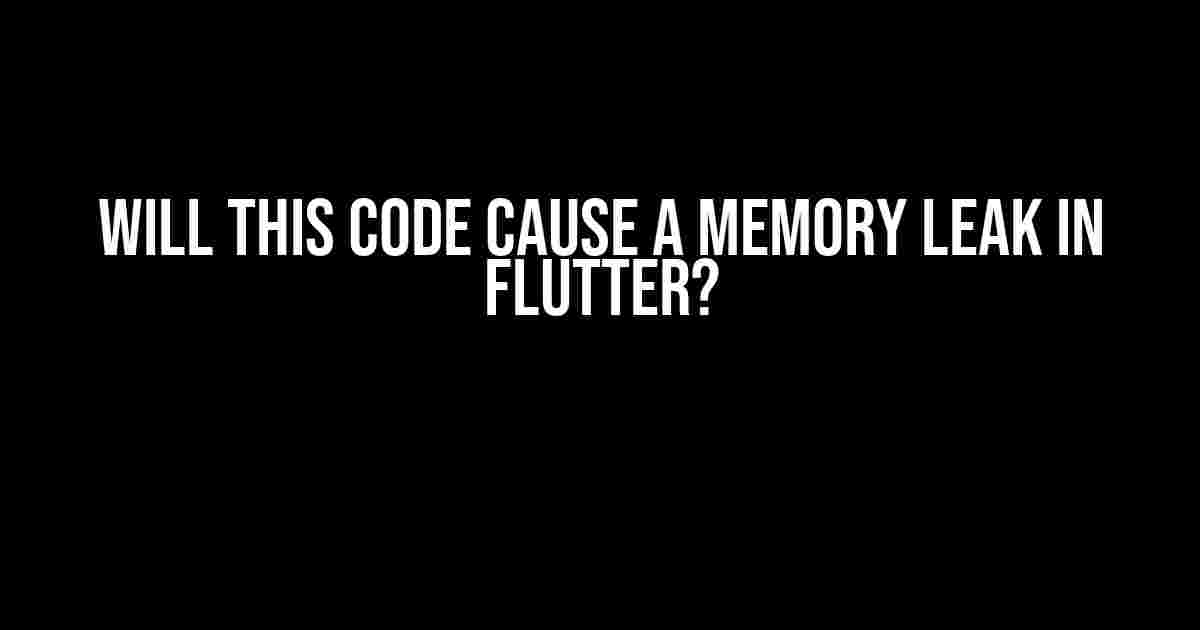As a Flutter developer, you’ve written some code and now you’re wondering if it’s going to cause a memory leak. You’re not alone! Memory leaks are a common issue in Flutter development, and it’s essential to identify and fix them to ensure your app runs smoothly and efficiently. In this article, we’ll dive deep into the world of memory leaks, explore the symptoms, and provide you with a step-by-step guide on how to detect and prevent them in your Flutter code.
What is a memory leak in Flutter?
A memory leak occurs when an object or a block of memory is allocated but not released, causing the memory to remain occupied even when it’s no longer needed. In Flutter, this can happen due to various reasons, such as:
- Unclosed streams or sinks
- Unused widgets or objects
- Leaks in native plugins or libraries
- Infinite loops or recursive functions
- Async operations not properly cancelled
Memory leaks can lead to performance issues, crashes, and even security vulnerabilities in your app. It’s crucial to identify and fix memory leaks as soon as possible to ensure a seamless user experience.
How to detect a memory leak in Flutter?
Before we dive into the code, let’s explore the symptoms of a memory leak in Flutter:
- Increasing memory usage over time
- Frequent garbage collection pauses
- Slow app performance or lag
- Crashes or freezes
To detect a memory leak, you can use the following tools and techniques:
1. Flutter’s built-in Observatory tool
The Observatory tool is a powerful debugging tool that comes with Flutter. You can use it to monitor your app’s memory usage, identify leaks, and even debug your code.
flutter run --observatory
This command will launch your app with the Observatory tool enabled. You can then use the Observatory UI to analyze your app’s memory usage and identify potential leaks.
2. VisualVM and Java Mission Control
VisualVM and Java Mission Control are third-party tools that can help you detect memory leaks in your Flutter app. You can use them to monitor your app’s memory usage, identify suspicious objects, and even take heap dumps.
3. Debugging with print statements
Sometimes, the simplest approach is the best one. You can use print statements to debug your code and identify potential memory leaks. For example:
class My_Widget extends StatefulWidget {
@override
_MyWidgetState createState() => _MyWidgetState();
}
class _MyWidgetState extends State {
@override
void didChangeDependencies() {
super.didChangeDependencies();
print('Dependencies changed!');
}
@override
void dispose() {
super.dispose();
print('Disposed!');
}
}
By adding print statements to your code, you can track the lifecycle of your widgets and identify potential memory leaks.
Common memory leak scenarios in Flutter
Now that you know how to detect memory leaks, let’s explore some common scenarios that can cause memory leaks in Flutter:
1. Unclosed streams or sinks
Streams and sinks are powerful tools in Flutter, but they can also cause memory leaks if not closed properly. For example:
class MyWidget extends StatefulWidget {
@override
_MyWidgetState createState() => _MyWidgetState();
}
class _MyWidgetState extends State {
StreamSubscription _subscription;
@override
void initState() {
super.initState();
_subscription = myStream.listen((event) {
print(event);
});
}
@override
void dispose() {
// _subscription.cancel(); // Forgot to cancel the subscription!
super.dispose();
}
}
In this example, the stream subscription is not cancelled, causing a memory leak. Make sure to cancel all stream subscriptions in the `dispose` method.
2. Unused widgets or objects
Unused widgets or objects can also cause memory leaks. For example:
class MyWidget extends StatelessWidget {
@override
Widget build(BuildContext context) {
return MaterialApp(
home: MyHomePage(),
);
}
}
class MyHomePage extends StatefulWidget {
@override
_MyHomePageState createState() => _MyHomePageState();
}
class _MyHomePageState extends State {
List _widgets = [];
@override
Widget build(BuildContext context) {
return Scaffold(
body: ListView.builder(
itemCount: 100,
itemBuilder: (context, index) {
return MyWidget();
},
),
);
}
}
In this example, the `MyWidget` instances are not properly disposed of, causing a memory leak. Make sure to use the correct lifecycle methods to dispose of unused widgets and objects.
3. Leaks in native plugins or libraries
Native plugins or libraries can also cause memory leaks in your Flutter app. For example:
import 'package:flutter_plugin/flutter_plugin.dart';
class MyWidget extends StatefulWidget {
@override
_MyWidgetState createState() => _MyWidgetState();
}
class _MyWidgetState extends State {
FlutterPlugin _plugin;
@override
void initState() {
super.initState();
_plugin = FlutterPlugin();
}
@override
void dispose() {
// _plugin.dispose(); // Forgot to dispose of the plugin!
super.dispose();
}
}
In this example, the native plugin is not properly disposed of, causing a memory leak. Make sure to follow the plugin’s documentation to properly dispose of native resources.
How to prevent memory leaks in Flutter
Now that you know how to detect and identify memory leaks, let’s explore some best practices to prevent them in your Flutter code:
1. Use the correct lifecycle methods
Make sure to use the correct lifecycle methods to dispose of widgets and objects. For example:
class _MyWidgetState extends State {
@override
void dispose() {
_subscription.cancel();
super.dispose();
}
}
In this example, the `dispose` method is used to cancel the stream subscription and dispose of the widget.
2. Use weak references
Use weak references to avoid strong references that can cause memory leaks. For example:
class MyWidget extends StatelessWidget {
final WeakReference _weakReference;
MyWidget(this._weakReference);
@override
Widget build(BuildContext context) {
return MyOtherWidget();
}
}
In this example, the `WeakReference` class is used to create a weak reference to the `MyWidget` instance.
3. Avoid infinite loops and recursive functions
Infinite loops and recursive functions can cause memory leaks by allocating memory indefinitely. For example:
void myFunction() {
while (true) {
// Do something
}
}
In this example, the `myFunction` function will allocate memory indefinitely, causing a memory leak. Make sure to use infinite loops and recursive functions carefully and with caution.
4. Use async/await correctly
Async/await can cause memory leaks if not used correctly. For example:
Future myFunction() async {
await Future.delayed(Duration(seconds: 10));
// Do something
}
In this example, the `myFunction` function will allocate memory indefinitely, causing a memory leak. Make sure to cancel async operations properly to prevent memory leaks.
Conclusion
Memory leaks can be a common issue in Flutter development, but with the right tools and techniques, you can detect and prevent them. By following the best practices outlined in this article, you can ensure your Flutter app runs smoothly and efficiently, providing a seamless user experience. Remember to always monitor your app’s memory usage, identify potential memory leaks, and use the correct lifecycle methods to dispose of widgets and objects. Happy coding!
| Best Practices to Prevent Memory Leaks in Flutter |
|---|
| Use the correct lifecycle methods to dispose of widgets and objects |
| Use weak references to avoid strong references |
| Avoid infinite loops and recursive functions |
| Use async/await correctly and cancel async operations properly |
By following these best practices, you can ensure your Flutter app is memoryHere are the 5 questions and answers about “Will this code cause a memory leak in Flutter?” in HTML format:
Frequently Asked Question
Don’t let memory leaks sabotage your Flutter app! Get the answers to the most pressing questions about code and memory leaks.
Q1: I’m using a stateful widget and creating a new object in the build method. Will this cause a memory leak?
No, this won’t cause a memory leak. The build method is called every time the widget needs to rebuild, and the objects created in the build method are garbage collected when the widget is rebuilt.
Q2: I’m using a StreamSubscription in my widget and not canceling it in the dispose method. Will this cause a memory leak?
Yes, this will cause a memory leak! If you don’t cancel the StreamSubscription, it will continue to listen to the stream even after the widget is disposed, causing a memory leak. Always cancel your subscriptions in the dispose method!
Q3: I’m using a static variable to hold a reference to an object. Will this cause a memory leak?
Maybe! If the static variable holds a reference to an object that’s not garbage collected, it can cause a memory leak. But if the object is garbage collected, the static variable won’t hold a reference to it anymore. Be cautious when using static variables!
Q4: I’m using a Timer in my widget and not canceling it in the dispose method. Will this cause a memory leak?
Yes, this will cause a memory leak! If you don’t cancel the Timer, it will continue to run even after the widget is disposed, causing a memory leak. Always cancel your Timers in the dispose method!
Q5: I’m using a Global Key and not disposing it when I’m done with it. Will this cause a memory leak?
Yes, this will cause a memory leak! If you don’t dispose of the Global Key, it will continue to hold a reference to the widget even after it’s been removed from the tree, causing a memory leak. Always dispose of your Global Keys when you’re done with them!


